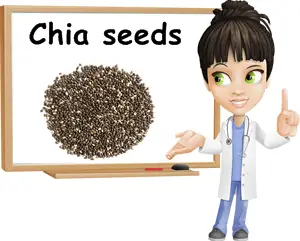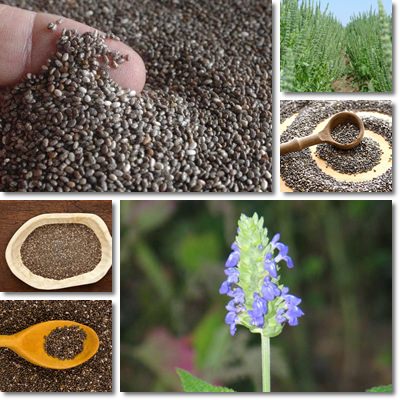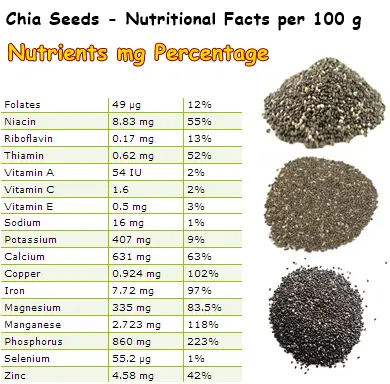In the past couple of years there has been a lot of fuss over chia seeds which have been intensely marketed as the ultimate ‘superfood’, a sort of cure-all food, unlike any other in terms of its health benefits. Indeed, chia seeds have a decent B vitamin content and more than impressive amounts of minerals, but so do most seeds such as sunflower seeds, sesame seeds, pumpkin seeds or pine nuts. Not to mention the fact that the term ‘superfood’ is but a marketing tool which offers no real guarantee as to the real impact of a certain food on one’s health.
Yes, chia seeds are healthier than some fruits and vegetables, but are they really so healthy that we should forsake all other seeds? Let’s see. Chia is a plant originating in present Mexico and Guatemala. It was a major food source for the Aztec population, who apparently relied on it for their very survival.

What do chia seeds look like?
There are two main varieties of the plant: Salvia hispanica and Salvia columbariae, the latter producing seeds of a more golden tint. Chia seeds are incredibly small, oval-shaped seeds and range in color from white, cream or golden to brown, light grey or dark grey, even black. Chia seeds are recognized as being rich in healthy fatty acids.
Chia seeds: debunking the myth
Chia seeds are an impressive source of amino acids, nutrients required for keeping in good health, but which our body cannot produce on its own. They are one of the few plants that contain Omega-3 fatty acids in the form of alpha-linoleic acid (ALA), but also Omega-6. But here is the catch: in order to produce as much benefits as the Omega-3 found in fish and seafood, alpha-linoleic acid must be converted into EPA and DHA, two forms with the utmost health benefits.
Chia seeds and Omega-3
But because our body can only convert a small part of ALA Omega-3 from chia seeds into EPA and DHA, fish remains a much better option for a healthy intake of Omega-3 fatty acids. Alternatively, a moderate intake of eggs could supply much needed Omega-3 fats. Studies show organic, free range eggs are more likely to provide higher Omega-3 fatty acids than all other types of eggs. Moreover, because there is a limit on how much chia seeds you can eat, one would also need to eat other plant sources of Omega 3 to ensure a sufficient intake and enjoy the health benefits of the fatty acid (see fish and seafood page).

Chia seeds protein absorption rate
As far as its protein content is concerned, a study published in the health and nutrition magazine Respyn uncovered that only around 34% of the protein content of chia seeds is absorbed at the intestinal level. Proteins from chia seeds flour however were absorbed almost entirely (80%), which would mean that chia seeds flour is probably a better, more nutritious option than chia seeds as they are in terms of protein absorption.
It has been theorized that grinding breaks down bigger elements and makes the nutrients in them more accessible and thus easier to absorb, hence the higher bioavailability of protein from chia seeds.
Chia seeds and vitamin C
The worst marketing lies belong to those claiming that chia seeds have 8 times more vitamin C than oranges. This is a shameless lie. Chia seeds contain about 1.6 mg of vitamin C/ 100 g of seeds (roughly around 2%) which is not very much at all, even compared to other common, readily available foods.
Compare this to a list of the richest, most common and readily available vitamin C foods:
- Kiwi fruit: 92.7 mg of vitamin C (154%)
- Papaya: 61.8 mg of vitamin C (103%)
- Strawberries: 58.8 mg of vitamin C (98%)
- Oranges: 53.2 mg of vitamin C (90%)
- Orange cantaloupe: 36.7 mg of vitamin C (61%)
- Mulberries: 36.4 mg of vitamin C (61%)
- Grapefruit: 31.2 mg of vitamin C (52%)
In addition to many other fruits rich in vitamin C, there are also several vegetables with an impressive amount of the vitamin. The conclusion to be drawn is that chia seeds have such a poor vitamin C content that they cannot even be considered when ranking the best 50 food sources of the vitamin, especially considering the recommended intake.
Chia seeds and iron
Another problem with chia seeds regards their iron content and absurd claims of being a better source of the mineral than spinach. Chia seeds indeed contain 7.72 mg of iron/100 g of seeds, representing 97% of the RDI. Spinach contains only 2.71 mg of iron/100 g, which is 34% of the RDI. However, while you can eat an entire bowl of spinach and feel great, eating more than 15 g of chia seeds can prove toxic for your body. Overall, spinach does provide more iron than chia seeds because its iron is more bioavailable and you can eat as much of it as you want, so you can easily up your intake to meet your individual nutritional demands.

What are the benefits of Chia Seeds?
Moderation is the key to a good life. If consumed in small amounts, chia seeds have their benefits. For instance, they are a wonderful source of soluble fiber: 11 g of fiber/100 g of seeds. Soluble fiber is believed to help lower cholesterol levels and regulate blood sugar levels. Insoluble fiber, like the type found in flax seeds, is a natural remedy for constipation and appears to soothe stomach disorders and even improve hemorrhoids (see what foods to eat and to avoid for hemorrhoids).
Because they stabilize blood sugar levels, chia seeds may reduce appetite and thus prove a good tool for losing weight. Also, their high fiber content makes them satiating, while their low carbohydrate content may be helpful in maintaining a good fat-protein-carbohydrate ratio. However, chia seeds boast no extraordinary weight-loss properties. It’s all about how much of anything you eat.
Another great benefit of chia seeds is their good calcium content. Three tablespoons of chia seeds contains about 300 mg of calcium.
If you are leading a vegan or vegetarian lifestyle, you can benefit immensely from consuming calcium rich foods such as sesame seeds, arugula, turnip greens, spinach, chia seeds and others. Last, but not least, they are gluten-free.
Like most seeds, chia seeds are excellent sources of minerals, as you can see in the table above. Calcium (63%), copper (102%), iron (97%), magnesium (83%), manganese (118%), phosphorus (223%) and zinc (42%) can be found in more than generous amounts in chia seeds. However, because consumption is limited to 10-15 g per day and eating them on a daily basis may prove harmful, it is best to substitute them with other healthier, more convenient foods when looking to meet daily nutritional demands.
Conclusion
If you want to supply your diet with fiber and minerals, you don’t have to go for chia seeds: sesame seeds, sunflower seeds or pumpkin seeds or any other seeds you might enjoy more are great options as well. If you want vitamin C, kiwifruit, strawberries, orange cantaloupe, papaya and oranges are far better sources than chia seeds. If you want protein, have some eggs which contain all essential amino acids and are thus a source of complete protein. If you like chia seeds, have some too. But remember there is a restriction to how much chia seeds you can eat, so moderation should be a guiding principle.
